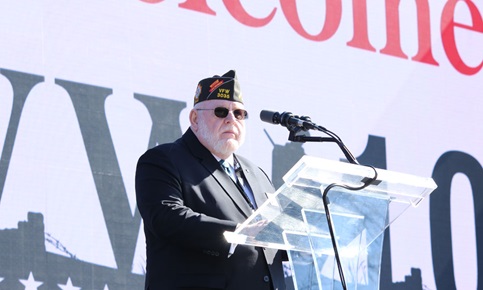WWI Centennial Commemoration Ceremony Recap
The WWI Centennial Commision's April 6, 2017, ceremony commemorated the centennial of US entry into WWI
Apr 10, 2017
Washington D.C. – The premiere production with moving tributes, compelling imagery and performances brought crowds to tears and to their feet as the United States World War I Centennial Commission hosted “In Sacrifice for Liberty and Peace: Centennial Commemoration of the U.S. Entry into World War I” yesterday at the National World War I Museum and Memorial in Kansas City, Missouri.
The commemoration events began with a moving prelude that included remarks by descendants of notable Generals John J. Pershing and George S. Patton. Highlights of the landmark day included a long-overdue Purple Heart Reuniting Ceremony with World War I Military Order of the Purple Heart medal recipient Cpl Leo George Rauf’s great nephew Michael Staton and marked his family’s four generations of military service. Native American Muscogee Creek spiritual leader Wotko Long offered a special blessing ceremony in recognition of the day, a reminder of the invaluable service and patriotism of Native Americans in World War l.
Missouri Governor Eric Greitens, U.S. Representative Emanuel Cleaver II and Kansas City Mayor Sylvester “Sly” James welcomed a crowd of some 4,000 people from 26 U.S. states and representatives from 28 nations.
“In Sacrifice for Liberty and Peace: Centennial Commemoration of the U.S. Entry into World War I,” produced by artistic director Edward Bilous, began with a spectacular flyover by the French Air Force Patrouille de France, creating trails of red, white and blue smoke, in tribute to the U.S. role in World War l. The stunning air display was followed by the National Anthem, performed by the 1st Infantry Division Band along with baritone John Brancy. The 1st Infantry Division Ft. Riley, Kansas, formed in World War I, and then known as the “Fighting First,” is currently deployed to Iraq.
Actor, director and producer Kevin Costner narrated the opening of the ceremony which took attendees, television and life-stream viewers back to the 1910s as war broke out in Europe, American volunteers signed up to fight, and German submarines sank the RMS Lusitania triggering the Great Debate as the nation headed into the 1916 presidential election.
The crowd honored the sacrifice of the men and women who served in World War I with a solemn moment of silence followed by the tolling of bells. The 1st Infantry Division Color Guard, in World War 1 period uniforms retired the colors. Cannons were fired by the Delta Battery, 1st Battalion, 129th Field Artillery Regiment Missouri Army Reserve National Guard to mark the Declaration of War, the start of a turning point in American history that took the country from a developing democracy into a world power.
The program paid tribute to the bravery of African American and Native American fighters; the struggle and patriotism of immigrant soldiers; and the significant impact on women, their standing in society and their civil rights. Noble Sissle Jr., descendant of famous WWI jazz composer Noble Sissle, read text by sociologist and civil rights activist W.E.B. Du Bois and Helen Keller’s famed “Strike Against War” speech was an eloquent reminder of the struggle with the decision to go to war.
Nations under the command of which U.S. soldiers fought, and U.S. Armed Forces fought against, were invited to read century-old passages about their respective nations’ reaction to the U.S. decision to enter the Great War. Representatives of Australia, Austria, Belgium, Canada, France, Hungary, Italy and the United Kingdom participated in the ceremony’s conclusion, painting a picture of a world at war and how the United States entry affected their nations.
The Acting Secretary of the U.S. Army Robert M. Speer read from President Calvin Coolidge’s speech delivered on November 11, 1926 at the dedication of the Liberty Memorial. He reminded the audience that today’s military carries the same ideals and values of U.S. soldiers in World War l. His remarks were followed by poems and prayers illustrating the nation’s concerns and fears for what was ahead. The ceremony finale, evoking the patriotic fervor that swept the United States, despite the national debate and anxiety, was a rousing full-cast performance of the iconic “Over There,” followed by a flyover by a B2 Spirit stealth bomber of the 509th Bomb Wing from Whiteman Air Force Base located in central Missouri.
In the afternoon, a panel of notable diplomats, historians and academics presented a colloquium on the global impact of World War I. The two-part discussion, with Dr. John Morrow, American historian and professor, University of Georgia; Dr. Michael Kazin, American historian and professor, Georgetown University; Dr. John Hamilton, Professor of Journalism, Louisiana State University; Emma Sky, OBE, British expert on the Middle East; and Evan Thomas, American journalist, historian and author, sought to answer critical questions such as how to build peace after a global conflict, why the U.S. entered the war and whether entering the war was the right decision.
By Chris Isleib
Director of Public Affairs, U.S. World War One Centennial Commission